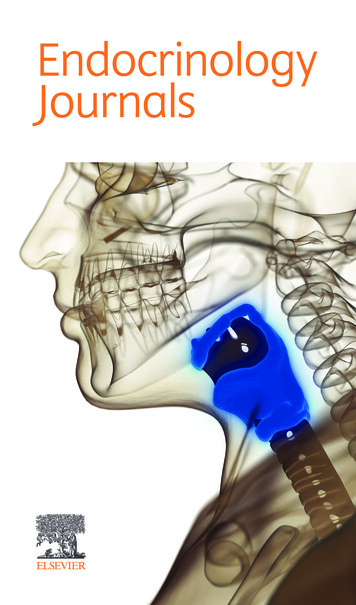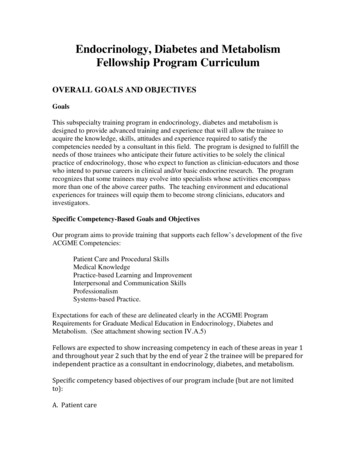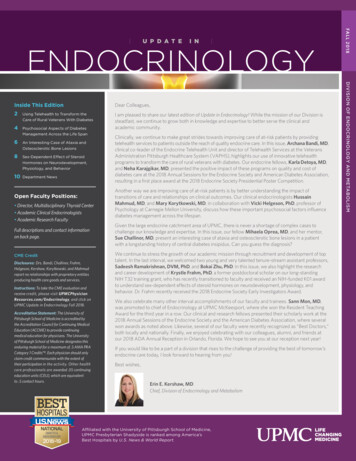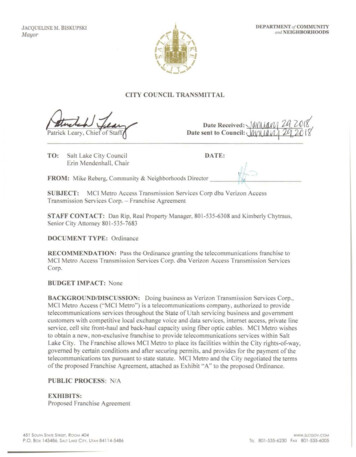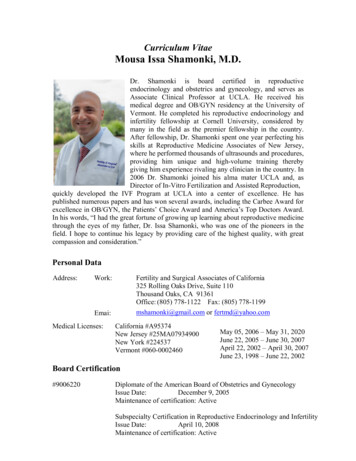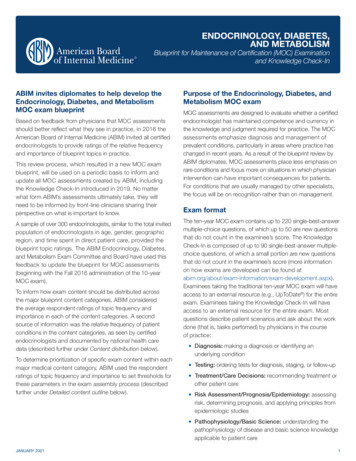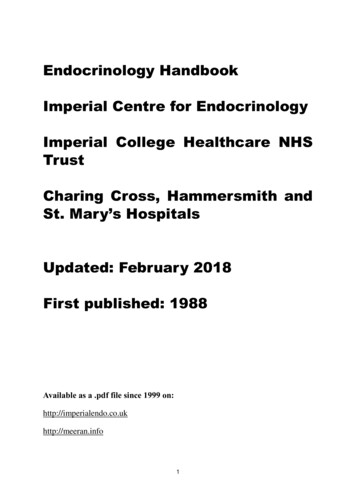
Transcription
110. Endocrinology I MEDCHEM 535 Diagnostic Medicinal ChemistryEndocrinologyThe endocrine system is made up of a complex group of glands that secrete hormones.These hormones control reproduction, metabolism, growth and development. Thehormones also control situational response to our environment.The glands that make up the endocrine system include the thyroid, parathyroid,pancreas, ovaries, testes, adrenal, pituitary and hypothalamus. Other organs andtissues such as the kidney (renin) and the GI tract (GLP-1) also release hormones.Here we look at some of the more common endocrine disorders and tests you mightsee.A. Adrenal DisordersB. Thyroid DisordersC. Pancreatic Disorders
2A. Adrenal DisordersThe adrenal glands are attached to the kidneys. Their function is to receive eitherhormonal or nerve input and to release hormones that either control or modulate manyprocesses. The two adrenal glands are asymmetric with respect to the blood supplyand are of slightly different shapes. There are two distinct regions of the adrenal glands.1. Adrenal Medula: Manufactures and secretes the catecholamines (epinephrine andnorepinephrine: roughly 9:1 ratio) for direct release into the blood principally for energyregulation and responses to various kinds of stress (fight or flight). The catecholaminesact by binding to cell surface receptors on organs and tissues and exert their effects viasecond messenger systems. Circulating catecholamines can be released withinseconds of stimulatory input by the sympathetic nervous system. The catecholamineshave very short half-lives in the blood (20 to 120 seconds).
32. Adrenal Cortex: The adrenal cortex is subdivided into 3 zonesa. Zona reticularis: Here the sex steroid precursor DHEA and some androgens aremanufactured and released. DHEA circulates at the highest concentration in the bloodof the steroids and serves as a precursor to androgens and estrogens manufactured inother tissues. DHEA is not a precursor to the mineralocorticoids or the glucocorticoids.We won’t look at this.b. Zona fasciculata: Synthesizes and releases the glucocorticoid steroids (cortisoland cortisone). The glucocorticoids exert strong effects on energy metabolism andprolonged stress response in most cells in the body. Importantly, the glucocorticoidsalso act to suppress the immune response. The glucocorticoids bind to glucocorticoidreceptors (GR) in the cytosol of targeted cells. The glucocorticoid-receptor complexesenter the nucleus and control gene transcription.c. Zona glomerulosa: Synthesize and release the mineralocorticoid aldosterone whichcontrols electrolyte and volume via it’s effects on the kidney. Aldosterone binds tomineralocorticoid receptors (MR) in the cytosol. The aldosteronereceptor complexenters the nucleus and controls gene transcription.3. Control over hormone synthesis and releasea. The pituitary gland releases adrenocorticoid stimulating hormone (ACTH) which is apeptide hormone. It controls the synthesis of the steroid hormones and precursors. It isreleased from the hypothalamus/pituitary glands. ACTH controls glucocorticoid levels. Italso partially controls mineralocorticoid levels. There is a feedback loop whereby thecirculating adrenal hormones can inhibit the the release of the stimulating hormonesfrom the hypothalamus/pituitary axis (HPA axis).
4b. Renin angiotensin system. Aldosterone levels are also controlled by the reninangiotensin system. Specifically angiotensin II stimulates aldosterone release.4. Disorders and their classificationsWe are primarily concerned with disorders related to the adrenals. These disorders areclassified to aid in diagnosis and treatment.a. Primary disorder: A disorder in the operation of the adrenals themselves that leads toan over or under production of one or more of the hormones. A primary disorder canalso occur due to renal transplants. This can include the effects of adrenal tumors.b. Secondary disorder: A disorder of the pituitary that causes over or underproductionof ACTH secretion which control adrenal hormone release. These disorders can becaused by tumors and surgery.c. Tertiary disorder: A disorder of the hypothalamus that leads to under or overproduction of CRH is a tertiary disorder.
55. The two major classes of corticoidsa. Glucocorticoids: Cortisol (hydrocortisone) Cortisol levels in the blood are subjectto diurnal variation. Cortisol is the major glucocorticoid that is released from the adrenalzona fasciculata in response to ACTH. Cortisol levels vary throughout the day so thetime of blood sampling is important. Cortisone is much less active however it can beconverted via metabolism to the more active cortisol. Cortisone and cortisol are bothused as drugs. As you know there are a number of synthetic glucocorticoids agonistsand antagonists.b. Mineralocorticoids: Aldosterone Aldosterone is the major mineralocorticoid that isreleased from the zona glumerulosa in response to ACTH levels. As stated earlier,aldosterone release is also controlled by the renin-angiotension system as well asserum potassium. In the kidney aldosterone promotes Na (and water) reabsorption andK secretion into the distal tubule. Aldosterone also acts along the intestinal epitheliumto promote Na and water absorption and K secretion.CortisolCortisoneAldosterone6. Cortisol: Cortisol is highly protein bound in plasma to it’s own binding protein (96%).It is cleared renal excretion and by metabolism. Cortisol levels are measured in serum,saliva and urine. Serum cortisol levels undergo significant diurnal variation. Thus thereference ranges are time dependent. Cortisol is measured by a competitive ELISA orby LCMS/MS when symptoms don’t match with the ELISA results.Reference ranges: [8am; 5-25 µg/dL]; [6 pm; 3-15 µg/dL]; [rule of thumb; 8pm 50%of 8am] [24 hr urine; 10-100 µg]a. Hypercortisolism (Cushing’s Syndrome) is marked by high plasma cortisol andhigh total cortisol in a 24 hr urine (cortisol 200 µg/day in urine). Cushing’s Syndromecan be caused by endogenous or exogenous factors such as drugs. Relatively rare.Chronic Cushing’s Syndrome is marked by the redistribution of body fat and water(moon face/buffalo hump), thinning of the epidermis, hypertension as well as a wholehost of other symptoms (see below). Note that Cushing’s Disease is only one cause ofCushing’s Syndrome.
6Endogenous hypercortisolism: (1) Cushing’s Disease.The major cause (70%) is theoverproduction of ACTH (adrenal corticotrophic hormone) by the pituitary gland that iscaused by a benign tumor. This disease is then classified as a secondaryhypercortisolism. (2) The next major cause of endogenous hypercortisolism is anadrenal tumor. This condition is classified a primary hypercortisolism.Diagnosis tests and procedures: A number of tests are available to help diagnosehypercortisolism. Below are some major ones.(a) Serum Cortisol: Reference ranges: [8am; 5-25 µg/dL] [6 pm; 3-15 µg/dL] [ruleof thumb; 8pm 50% of 8am] Mayo site: Acute stress (including hospitalizationand surgery), alcoholism, depression, and many drugs (eg, exogenous cortisones,anti-convulsants) can obliterate normal diurnal variation, affect response tosuppression/stimulation tests, and cause elevated baseline levels.(b) Urine Cortisol (UFC): A 24 hour urine free cortisol test (UFC), reference range[24 hr urine; 10-100 µg] where total cortisol greater than 200 µg indicatedhypercortisolism. This is a preferred test.(c) DST Dexamethasone suppression test (DST). Dexamethasone (a syntheticglucocorticoid agonist) inhibits the release of ACTH from the pituitary. There aretwo tests here. The more common low dose test is dexamethasone (1 mg; 11 pm)followed by an 8am serum cortisol. If serum cortisol levels are not suppressed(cortisol 5 µg/dL), Cushing’s disease is suspected).
7(d) Radioimmunoassay (RIA) or ELISA Chemiluminescence assay for ACTH inthe blood (10-60 pg/mL (a.m. draws)). This test directly detects hyper-secretion ofACTH (pituitary secondary Cushings Syndrome; Cushings disease). There is alsoa test for CRH hypersecretion by the pituitary to differentiate between secondaryand tertiary Cushings Syndrome).(e) Abdominal CT scans and pituitary MRI.Treatment for hypercortisolism depends on the cause. It may include tumor removalusually adrenalectomy followed-on by temporary or permanent administration ofsupplemental glucocorticoid steroids (hydrocortisone, prednisolone). Note that somedrugs (most frequently mitotane, ketoconazole, metyrapone) can be used to inhibitcortisol synthesis in the adrenal with some success.Exogenous (iatrogenic) hypercortisolism is caused by treatment with naturalcorticosteroids. In addition there are a number of synthetic corticosteroids used ininflammatory disease and for immunosuppression that produce effects likehypercortisolism. These drugs may appear to augment the effects of the normalglucocorticoids but can cause concurrent adrenosuppression due to inhibition of ACTHrelease. They also may have undesireable have mineralocorticoid effects.b. Hypocortisolism is marked by low plasma cortisol and low urine cortisol.Hypocortisolism is much more common. Often other hormones produced by theadrenals such as aldosterone (see below mineralocorticoid) and DHEA (sex steroidprecursor), are low as well.!
8a. Primary Adrenocortical Insufficiency (Addison’s disease) can be caused by geneticmutations, destruction of the adrenal cortex by cancer, tuberculosis, AIDS,autoimmune disease. It is also observed upon sudden steroid withdrawal due toatrophy of the cortex caused by prolonged use of corticosteroids. Symptoms includefatigue, low blood pressure, salt craving, weight loss and darkening of skin. Stress canprecipitate an acute adrenal crisis that is marked by hypovolemic shock, hypotensionand hypoglycemia and must be treated immediately with fluids and iv hydrocortisone.(a) Blood tests include cortisol (low to low normal), early morning ACTH (elevated),aldosterone (low) and urine cortisol (low).(b) Cosyntroprin Challenge: Patients are given a test dose of synthetic ACTH (1-24ACTH; short corticotropin; cosyntropin) and plasma cortisol levels are monitored.The normal rise in cortisol levels (to 20 µg/dL increase after 30 minutes) is notobserved in Addison’s disease. This test can also be used to diagnosehypoaldosteronism (see below) where aldosterone levels are also measured in thetest.b. Secondary Adrenocortical Insufficiency is most often caused by chronic steroid usewith drugs that also inhibit the release of ACTH. Ademoma of the pituitary is anothercause. Note: While the cosyntropin test should reveal a normal response (normal risein serum cortisol) this is not always observed as the adrenal gland function may declinewith chronic steroid use and pituitary adenoma.c. Treatment for chronic hypocortisolism consists of oral administration of prednisone,cortisone or cortisone acetate bid or tid. Longer acting steroids are not indicated.7. Aldosterone: Aldosterone levels are measure in serum and urine by LC/MS (liquidchromatography mass spectrometry. It is subject to diurnal variation and varies withage. In addition levels are 50% higher when samples are taken in the upright vssupine position. Units for this direct test are given as ng/dL.a. Hyperaldosteronism Hypersecretion of aldosterone can accompanyhypercortisolism due to high ACTH however the renin angiotensin system is of primaryimportance. Aldosterone has minimal feedback effects of ACTH release.(a) Primary hyperaldosteronism leads to hypertension, hypernatremia andhypokalemia. As for primary hypercortisolism, the principal cause is adenomas ofthe adrenal gland that secrete aldosterone even when renin is suppressed.(b) Secondary hyperaldosteronism has two major causes: (1) High ACTH causedby a pituitary tumor, high ACTH and can be further diagnosed with adexamethasone test as above. (2) However a very likely case is elevatedangiotensin II however this is not measure directly. A differential diagnosisbetween (1) and (2) involves a comparison of the plasma renin activity (PRA) andthe plasma aldosterone concentration (PAC). PRA is measured in the patient’splasma by determining the rate of formation of Angiotensin 1 from renin. The units
9here are ng/mL/hr. The ratio of PAC (ng/dL) to PAR (ng/mL/hr) is also used in theanalysis.(c) Spironolactone, a potassium-sparing diurectic and aldosterone antagonist, isused to treat hyperaldosteronism.b. Hypoaldosteronism: Low aldosterone levels are often observed in primary andsecondary hypocortisolism. There is a syndrome called Salt Wasting Syndrome that isassociated with a deficiency in one of the enzymes of the aldosterone synthesispathway (a 21-hydroxylase). Treatment of hypoaldosteronism is with a syntheticmineralocorticoid (fludrocortisone acetate). Fludrocortisone does have someglucocorticoid effect as well. This treatment can be chronic.
controls electrolyte and volume via it’s effects on the kidney. Aldosterone binds to mineralocorticoid receptors (MR) in the cytosol. The aldosteronereceptor complex enters the nucleus and controls gene transcription. 3. Control over hormone synthesis and release a. The pituitary gland rele
